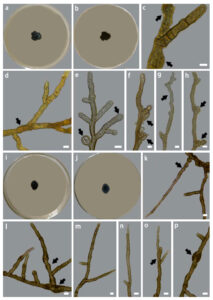Intumescentia tinctorum H.L. Si, R.L. Chang, T. Bose & Y.C. Wang, in Si, Wang, Liu, Li, Bose & Chang, Journal of Fungi 9(4, no. 423): 9 (2023)
Index Fungorum Number: IF 844857; MycoBank Number: MB 844857; Facesoffungi Number: FoF 15840
Etymology – Named after its host lichen species, Parmotrema tinctorum.
Holotype – China, Yunnan Province: Tiesuo Township, 26°32′71”N, 100°57′3”E, ca. 2115 m elev., isolated from Parmotrema tinctorum, 17 January 2021, H.L. Si, CX97C16 (HMAS 352171), ex-type Culture CGMCC3.23634.
GenBank Accession Numbers – ITS: OP345149, LSU: OP345116, SSU: OP345114, ACT: OP354478, CAL: OP354484, RPB2: OP354472, TEF1: OP354466.
Description – Hyphae are smooth, light brown in color, septate, multi-guttulate, and branched; compartments are variable in size and are often distorted, measuring 2.01–5.05 μm (x̄ = 3.23 μm, n = 50), usually with hyphal swelling that is globose to sub-globose in shape, and apical or intercalary in position, and lateral branching usually arises from swollen or distorted compartments; juvenile hyphae are usually slightly curved. Asexual and sexual structures were not observed.
Colony morphology and growth – Colony on PDA after 30 days at 20 °C is black-brown in color (top and reverse), compact, with a surface that is greenish gray in color, minutely tomentose, margins are entire and irregularly lobed. Optimal growth temperature is 20 °C (0.31 mm/day). Growth was observed at 5 °C (0.06 mm/day), whereas no growth was detected at 35 °C.
Additional specimens examined – China, Yunnan Province: Tiesuo Township, 26°32′71” N, 100°57′3” E, ca. 2115 m elev., isolated from Parmotrema tinctorum, 17 January 2021, H.L. Si, CX97C1, ex-type Culture CGMCC3.23633, GenBank: ITS: OP345115, LSU: OP345111, SSU: OP345113, ACT: OP354477, CAL: OP354483, RPB2: OP354471, TEF1: OP354465; China, Yunnan Province: Tiesuo Township, 26°32′71” N, 100°57′3” E, ca. 2115 m elev., isolated from Parmotrema wallichiana, 17 January 2021, H.L. Si, CX96C5, ex-type Culture CGMCC3.23636, GenBank: ITS: OP289531, LSU: OP326178, SSU: OP326174, ACT: OP354476, CAL: OP354482, RPB2: OP354470, TEF1: OP354464.
Notes – In the phylogenetic analyses of single genes and concatenated datasets, the three isolates of I. tinctorum emerged as a monophyletic lineage (Figure 1). This fungal species shares both congruent and distinct morphological characteristics with closely related species (Table 1). Additionally, I. tinctorum has the lowest optimal growth temperature compared to other species in this genus (Table 1).

Figure 1 – Colony morphology of Intumescentia tinctorum sp. nov. (CGMCC3.23634) on PDA medium after 30 days at 25 °C, (a) top, (b) reverse, hyphal morphology (c–e) branched hyphae with intercalary swelling, (e) apical hyphal swelling, (f) lateral branch emerging from swollen and distorted hyphal swelling, (g) slightly curved juvenile hyphae with distorted apex; (h) distorted lateral branching; colony morphology of Intumescentia vitii sp. nov. (CGMCC3.23741) on PDA medium after 30 days at 25 °C, (i) top, (j) reverse, hyphal morphology (k) peanut-shaped compartments, (l–p) a variety of swollen and distorted compartments with branches emerging from the base of septa. Bars = 5μm. Morphological structures listed above are indicated with arrows.

Table 1 – Comparison of the morphological characters and growth rate of Intumescentia species recovered in this study.
